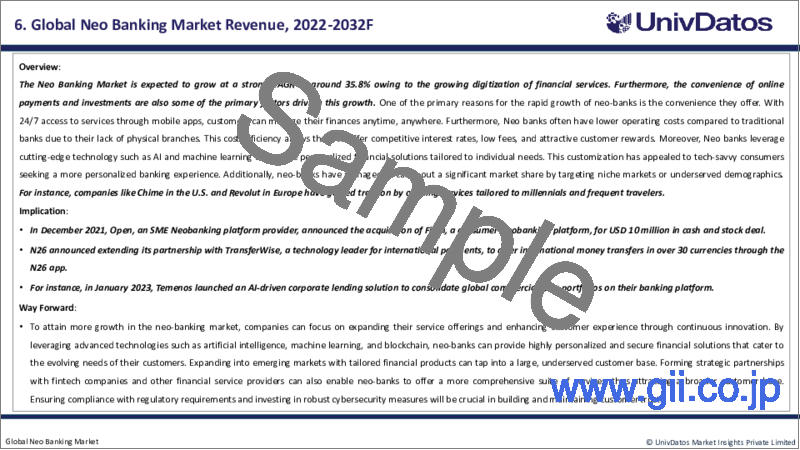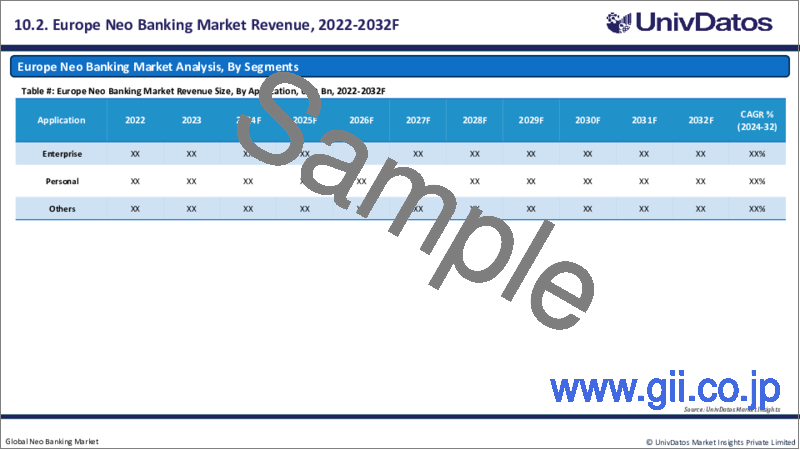|
|
市場調査レポート
商品コード
1461379
ネオバンキング市場:現状分析と予測(2023-2030年)Neo Banking Market: Current Analysis and Forecast (2023-2030) |
||||||
カスタマイズ可能
|
|||||||
| ネオバンキング市場:現状分析と予測(2023-2030年) |
|
出版日: 2024年03月01日
発行: UnivDatos Market Insights Pvt Ltd
ページ情報: 英文 134 Pages
納期: 即日から翌営業日
|
- 全表示
- 概要
- 目次
ネオバンキング市場は、金融サービスのデジタル化の進展により、CAGR約35.8%の高成長が見込まれており、さらにオンライン決済の利便性や投資もこの成長を促進する主な要因の一つとなっています。ネオバンクの急成長の主な理由のひとつは、その利便性にあります。モバイル・アプリを通じて24時間365日いつでもサービスにアクセスできるため、顧客はいつでもどこでも財務を管理できます。さらに、ネオバンクは実店舗を持たないため、従来の銀行と比べて運営コストが低い場合が多いです。このコスト効率により、競争力のある金利、低手数料、魅力的な特典を顧客に提供することができます。さらに、ネオ・バンクはAIや機械学習などの最先端テクノロジーを活用し、個人のニーズに合わせたパーソナライズされた金融ソリューションを提供しています。このカスタマイズは、よりパーソナライズされたバンキング体験を求めるテクノロジーに精通した消費者にアピールしています。さらに、ニッチ市場や十分なサービスを受けていない層をターゲットにすることで、ネオバンクは大きな市場シェアを獲得しています。例えば、米国のチャイムや欧州のリボルートのような企業は、ミレニアル世代や頻繁に旅行する人に合わせたサービスを提供することで人気を博しています。さらに、この高成長は、この業界に対する政府の支援も後押ししています。各国政府はフィンテック・イノベーションの可能性を認識し、ネオバンキング新興企業の成長を促進するために規制上のサンドボックスを導入しています。このような支援的な規制環境は、起業家や投資家のこの市場への参入を後押ししています。例えば、2021年、世界の決済処理プラットフォームであるStripeは、資金調達ラウンドで6億米ドルを調達し、同社の価値を950億米ドルと評価しました。
口座タイプに基づき、市場はビジネス口座と貯蓄口座に分類されます。ビジネス口座分野が市場シェアの大半を占めています。その主な要因は、その目的と実用性です。ビジネス口座は主に、起業家、新興企業、中小企業(SME)が日々の金融取引を効率的に管理できるように設計されています。これらの口座は、請求書発行、給与管理、経費追跡、会計ソフトとの統合など、ビジネスが円滑に運営されるために不可欠なサービスを幅広く提供しています。一方、普通預金口座は、個人の貯蓄と長期的な資産拡大を支援することに重点を置いており、個人の銀行ニーズに合わせた機能や特徴は限られています。さらに、ネオバンクの観点からは、普通預金口座に比べ、ビジネス口座の方が有利な収益機会があります。通常、企業は取引量が多く、頻繁にキャッシュフローを必要とするため、プレミアム顧客サポートや高度な財務管理ツールなどの追加サービスにお金を払うことを厭わないです。このため、ネオバンクにとっては、口座維持手数料や取引手数料、クロスセリングの機会が増え、最終的には持続可能な収益源として貢献することになります。さらに、ビジネス口座では、金融活動のレベルが高く、詐欺行為やマネー・ロンダリングのリスクにさらされる可能性があるため、強固なリスク管理とコンプライアンス・プロセスが求められます。ビジネス口座を提供するネオバンクは、顧客の資金の安全性と完全性を確保するため、高度なセキュリティ対策、不正検知システム、コンプライアンス・チェックに多額の投資を行っています。これにより、特にセキュリティと信頼性が最重要視されるデジタルバンキングにおいて、企業の信頼を確立しています。一方、普通預金口座は残余リスクやコンプライアンス要件が低いため、管理や運用が比較的簡単です。
サービス別に見ると、市場はモバイル・バンキング、決済、送金、貯蓄・投資、ローン、その他に区分されます。ネオバンクにとって最大の収益を生み出すアプリケーションは、モバイル・バンキングです。スマートフォンの普及が進み、デジタル取引の重要性が高まる中、モバイル・バンキングは、財務管理に利便性とアクセシビリティを求める顧客にとって不可欠なツールとなっています。ネオバンクは、現代の金融ニーズに応えるシームレスでユーザーフレンドリーなモバイル・バンキング体験を提供することで、この動向を活用してきました。さらに、新しいモバイル・バンキング・サービスが消費者に高く受け入れられている背景には、ユーザーフレンドリーなインターフェースなど、いくつかの要因があります。例えば、ネオバンクはユーザーの体験を優先し、顧客が様々なバンキング・サービスを簡単に利用できる直感的なインターフェースを提供しています。モバイル・バンキング・アプリケーションのシンプルさと利便性は、顧客の満足度とロイヤルティを高める。さらに、ネオバンキングが消費者に提供するアクセシビリティとセキュリティ機能は、消費者の信頼を築き、消費者がいつでもどこでも口座にアクセスできるアクセシビリティの高さは、ネオバンクにとって消費者維持の重要な原動力となっています。
アプリケーションの種類によって、市場は企業向け、個人向け、その他に区分されます。市場シェアの大半を占めるのは企業向けアプリケーションです。ネオバンクは、エンタープライズ・アプリケーションが収益性の高い収益源であることを見出しています。これらのアプリケーションは、企業や法人顧客向けにカスタマイズされ、リアルタイムの支払い処理、給与管理、経費追跡、財務報告などの包括的な一連のサービスを提供します。その目的は、あらゆる規模の企業の業務効率を高め、プロセスを合理化することです。シームレスでユーザーフレンドリーなインターフェイスを持つネオバンクは、企業セグメントで実質的な市場シェアを獲得しています。エンタープライズ・アプリケーション分野でのネオバンクの拡大は、さまざまな要因によるものと考えられます。重要な要因のひとつは、より迅速で効果的な金融サービスの必要性に後押しされ、企業の間でデジタル・バンキング・ソリューションに対する要求が高まっていることです。伝統的な銀行は、その手続きの遅さや負担の大きさが批判され、多くの企業がより柔軟で迅速な代替手段として新しい銀行を求めるようになった。このような要因が、ネオバンキングのエンタープライズ・ソリューション分野を、長期的に続くと予想される高成長軌道に押し上げる上で極めて重要な役割を果たしています。
市場に関する理解を深めるため、市場は北米(米国、カナダ、その他北米地域)、欧州(ドイツ、英国、フランス、スペイン、イタリア、その他欧州地域)、アジア太平洋地域(中国、日本、インド、その他アジア太平洋地域)、世界のその他の地域における世界のプレゼンスに基づいて分析されています。ネオバンキング業界では欧州が最大のシェアを占めています。ネオバンキング市場において欧州が主導的地位を占めている主な要因のひとつは、金融規制環境が整っているため、ネオバンキング業界がかつてない勢いで成長していることです。例えば、欧州で2017年に開始された欧州連合(EU)の決済サービス指令2(PSD2)は、オープンバンキングAPIを通じてサードパーティによる銀行データへのアクセスを可能にすることで電子決済サービスを強化・規制し、金融セクターにおけるイノベーションと競争を促進する上で極めて重要な役割を果たしています。さらに、欧州ではフィンテック、伝統的な銀行、規制機関の間で協力的なエコシステムが構築されており、ネオバンキング産業が同地域で成長するのに非常に有利な環境が整っています。例えば、ネオバンキング・サービス・プロバイダーと伝統的な銀行とのパートナーシップは、これらのデジタル専用銀行が急速に拡大し、消費者基盤を急速に成長させることを可能にしています。例えば、英国を拠点とするネオバンクのリボルートとHSBCのような伝統的な銀行との提携は、欧州の金融セクターにおける協業へのシフトを示唆しています。さらに、欧州におけるデジタル・イノベーションの文化的受容度の高さも、同地域におけるネオ・バンクの成功の大きな原動力となっています。例えば、ドイツを拠点とするN26というネオ・バンクは、欧州全体で約700万人の消費者ベースの成長率を報告しているが、これは同地域でネオ・バンクが文化的に受け入れられていることを裏付けています。このような要因が大きな原動力となり、欧州は銀行業界が最も栄えた地域のひとつとなっています。
同市場で事業を展開する主要企業には、N26 AG、Revolut Ltd、Chime Financial, Inc、Monzo, Inc、Starling Bank、Varo Bank, N.A、Atom bank、Monese Ltd、The Goldman Sachs Group, Inc.、Tandem Bankなどがあります。
目次
第1章 市場イントロダクション
- 市場の定義
- 主な目標
- ステークホルダー
- 制限事項
第2章 調査手法または前提条件
- 調査プロセス
- 調査手法
- 回答者プロファイル
第3章 市場要約
第4章 エグゼクティブサマリー
第5章 COVID-19がネオバンキング市場に与える影響
第6章 ネオバンキング市場収益 , 2020-2030F.
第7章 アカウントタイプ別の市場分析
- ビジネスアカウント
- 普通預金口座
第8サービス別の市場分析
- モバイルバンキング
- 支払い
- 送金
- 貯蓄と投資
- ローン
- その他
第9アプリケーションタイプ別の市場分析
- 企業
- 個人
- その他
第10章 地域別市場分析
- 北米
- 米国
- カナダ
- その他北米地域
- 欧州
- ドイツ
- 英国
- フランス
- イタリア
- その他欧州地域
- アジア太平洋
- 中国
- インド
- 日本
- 韓国
- その他アジア太平洋地域
- 世界のその他の地域
第11章 ネオバンキング市場力学
- 市場促進要因
- 市場の課題
- 影響分析
第12章 ネオバンキング市場機会
第13章 ネオバンキング市場動向
第14章 需要と供給の分析
- 需要側分析
- 供給側分析
第15章 バリューチェーン分析
第16章 競争シナリオ
- 競合情勢
- ポーターのファイブフォース分析
第17章 会社概要
- N26 AG
- Revolut Ltd
- Chime Financial, Inc
- Monzo, Inc
- Starling Bank
- Varo Bank, N.A
- Atom bank
- Monese Ltd
- The Goldman Sachs Group, Inc.
- Tandem Bank
第18章 免責事項
Neo-banking can be defined as a digital banking approach that provides a range of financial services to customers while operating primarily through digital platforms without any physical branch presence. These banks offer a seamless, user-friendly, and technology-driven banking experience to individuals and businesses, often through mobile apps or web interfaces. Neo-banks typically focus on a specific niche, such as payments, lending, savings, or investment management, and leverage advanced technologies like artificial intelligence, machine learning, and application programming interfaces (APIs) to deliver their services.
The Neo Banking Market is expected to grow at a strong CAGR of around 35.8% owing to the growing digitization of financial services, furthermore, the convenience of online payments, and investments are also some the primary factors driving this growth. One of the primary reasons for the rapid growth of neo-banks is the convenience they offer. With 24/7 access to services through mobile apps, customers can manage their finances anytime, anywhere. Furthermore, Neo banks often have lower operating costs compared to traditional banks due to their lack of physical branches. This cost-efficiency allows them to offer competitive interest rates, low fees, and attractive rewards to customers. Moreover, Neo banks leverage cutting-edge technology such as AI and machine learning to provide personalized financial solutions tailored to individual needs. This customization has appealed to tech-savvy consumers seeking a more personalized banking experience. Additionally, by targeting niche markets or underserved demographics, neo-banks have managed to carve out a significant market share. For instance, companies like Chime in the U.S. and Revolut in Europe have gained traction by offering services tailored to millennials and frequent travelers. Furthermore, this high growth is also fueled by the conducive government support to this industry as well. Governments in various countries have recognized the potential of fintech innovation and have introduced regulatory sandboxes to foster the growth of neo-banking startups. This supportive regulatory environment has encouraged entrepreneurs and investors to enter this market. For instance, in 2021, Stripe, a global payments processing platform, raised USD S600 million in a funding round, valuing the company at USD 95 billion, underscoring investor confidence in fintech companies.
Based on the account type, the market is categorized into business accounts and savings accounts. The business account segment holds the majority of the market share. The primary factor responsible for this domination includes its purpose and utility. Business accounts are primarily designed for entrepreneurs, startups, and small to medium-sized enterprises (SMEs) to manage their daily financial transactions effectively. These accounts offer a wide array of services such as invoicing, payroll management, expense tracking, and integrations with accounting software, which are crucial for businesses to operate smoothly. In contrast, savings accounts are more focused on helping individuals save and grow their personal wealth over time, with limited features and functionality tailored to individual banking needs. Furthermore, from a neobank's perspective, business accounts present a lucrative opportunity for revenue generation compared to savings accounts. Businesses typically have higher transaction volumes, and frequent cash flow requirements, and are willing to pay for additional services like premium customer support and advanced financial management tools. This translates into higher account maintenance fees, transaction fees, and cross-selling opportunities for neo-banks, ultimately contributing to a more sustainable revenue stream. Additionally, Business accounts require robust risk management and compliance processes due to the higher level of financial activity and potential exposure to fraudulent activities or money laundering risks. Neobanks offering business accounts invest significantly in advanced security measures, fraud detection systems, and compliance checks to ensure the safety and integrity of their customers' funds. This instills trust among businesses, especially in the digital banking landscape where security and reliability are paramount considerations. Savings accounts, on the other hand, have lower risk exposure and compliance requirements, making them relatively simpler to manage and operate.
Based on services, the market is segmented into mobile banking, payments, money transfer, savings and investments, loans, and others. The application that generates the maximum revenue for neo-banks is mobile banking. With the increasing adoption of smartphones and the growing importance of digital transactions, mobile banking has become an indispensable tool for customers seeking convenience and accessibility in managing their finances. Neo banks have capitalized on this trend by delivering seamless and user-friendly mobile banking experiences that cater to modern-day financial needs. Furthermore, several factors have contributed to the high acceptability of the new mobile banking services among consumers, such as a user-friendly interface. For instance, Neo banks prioritize user experience, offering intuitive interfaces that make it easy for customers to navigate through various banking services. The simplicity and convenience of mobile banking applications enhance customer satisfaction and loyalty. Moreover, the accessibility and the security features that the neo banking provides to their consumers build trust among the consumers, and the level of accessibility, allowing consumers to access their accounts anytime and anywhere is a key driver of consumer retention for the neo banks.
Based on application type, the market is segmented into enterprise, personal, and others. The enterprise application holds the majority of the market share. Neo banks have found enterprise applications to be a highly profitable source of revenue. These applications are customized for businesses and corporate clients, offering a comprehensive suite of services including real-time payment processing, payroll management, expense tracking, and financial reporting. The aim is to enhance operational efficiency and streamline processes for businesses of all scales. With their seamless and user-friendly interfaces, neo-banks have effectively gained a substantial market share in the enterprise segment. The expansion of neo-banks in the enterprise application sector can be attributed to various factors. A significant factor is the rising requirement for digital banking solutions among businesses, fueled by the necessity for quicker and more effective financial services. Traditional banks have faced criticism for their sluggish and burdensome procedures, prompting numerous businesses to seek out new banks as a more flexible and responsive alternative. Factors like these have played a pivotal role in driving the enterprise solutions segment of the neo banking to a path of high secular growth which is expected to continue for a large period.
For a better understanding, the market is analyzed based on its worldwide presence in countries such as North America (The U.S., Canada, and the Rest of North America), Europe (Germany, The U.K., France, Spain, Italy, Rest of Europe), Asia-Pacific (China, Japan, India, Rest of Asia-Pacific), Rest of World. Europe holds the largest share of the neo-banking industry. One of the key factors contributing to this leadership position of Europe in the neo-banking market is its conducive financial regulatory environment helping the industry to thrive at an unprecedented rate. For instance, the European Union's Payment Services Directive 2 (PSD2) launched in 2017 in Europe, has played a pivotal role in fostering innovation and competition in the financial sector by enhancing and regulating electronic payment services by allowing third-party access to banking data through open banking APIs. Furthermore, the collaborative ecosystem in Europe amongst fintech, traditional banks, and regulatory bodies has laid down a very favorable environment for the neo-banking industry to thrive in the region. For instance, the partnership between the neo-banking services providers and the traditional banks has enabled these digital-only banks to expand fast and grow their consumer base at a rapid rate. For instance, the partnerships between UK-based neo-bank Revolut and traditional banks like HSBC, signal a shift towards collaboration in the European financial sector. Moreover, the high cultural acceptance of digital innovation in Europe has played a major driving force behind the success of neo-banks in the region. For instance, the rate at which a German-based neo-bank named N26 has reported its growth numbers regarding its consumer base, of about 7 million consumers across Europe underscores the cultural acceptance of neo-banking in the region. Factors like these have played a major driving force, making Europe one of the dominant regions where the banking industry has flourished the most.
Some of the major players operating in the market include N26 AG; Revolut Ltd; Chime Financial, Inc; Monzo, Inc; Starling Bank; Varo Bank, N.A; Atom bank; Monese Ltd; The Goldman Sachs Group, Inc.; and Tandem Bank
TABLE OF CONTENTS
1.MARKET INTRODUCTION
- 1.1.Market Definitions
- 1.2.Main Objective
- 1.3.Stakeholders
- 1.4.Limitation
2.RESEARCH METHODOLOGY OR ASSUMPTION
- 2.1.Research Process of the Neo Banking Market
- 2.2.Research Methodology of the Neo Banking Market
- 2.3.Respondent Profile
3.MARKET SYNOPSIS
4.EXECUTIVE SUMMARY
5.IMPACT OF COVID-19 ON THE NEO BANKING MARKET
6.NEO BANKING MARKET REVENUE (USD BN), 2020-2030F.
7.MARKET INSIGHTS BY ACCOUNT TYPE
- 7.1.Business Account
- 7.2.Savings Account
8.MARKET INSIGHTS BY SERVICES
- 8.1.Mobile Banking
- 8.2.Payments
- 8.3.Money Transfers
- 8.4.Saving and Investments
- 8.5.Loans
- 8.6.Others
9.MARKET INSIGHTS BY APPLICATION TYPE
- 9.1.Enterprise
- 9.2.Personal
- 9.3.Others
10.MARKET INSIGHTS BY REGION
- 10.1.North America
- 10.1.1.The U.S.
- 10.1.2.Canada
- 10.1.3.Rest of North America
- 10.2.Europe
- 10.2.1.Germany
- 10.2.2.The U.K.
- 10.2.3.France
- 10.2.4.Italy
- 10.2.5.Rest of Europe
- 10.3.Asia-Pacific
- 10.3.1.China
- 10.3.2.India
- 10.3.3.Japan
- 10.3.4.South Korea
- 10.3.5.Rest of Asia-Pacific
- 10.4.Rest of the World
11.NEO BANKING MARKET DYNAMICS
- 11.1.Market Drivers
- 11.2.Market Challenges
- 11.3.Impact Analysis
12.NEO BANKING MARKET OPPORTUNITIES
13.NEO BANKING MARKET TRENDS
14.DEMAND AND SUPPLY-SIDE ANALYSIS
- 14.1.Demand Side Analysis
- 14.2.Supply Side Analysis
15.VALUE CHAIN ANALYSIS
16.COMPETITIVE SCENARIO
- 16.1.Competitive Landscape
- 16.1.1.Porters Fiver Forces Analysis
17.COMPANY PROFILED
- 17.1.N26 AG
- 17.2.Revolut Ltd
- 17.3.Chime Financial, Inc
- 17.4.Monzo, Inc
- 17.5.Starling Bank
- 17.6.Varo Bank, N.A
- 17.7.Atom bank
- 17.8.Monese Ltd
- 17.9.The Goldman Sachs Group, Inc.
- 17.10.Tandem Bank






